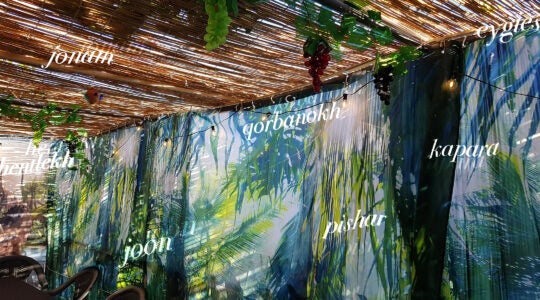NEW YORK (JTA) — More American Jews will converge this summer on a single spot of real estate than at any time in American history. The locus will be MetLife Stadium in East Rutherford, N.J.; the reason for the coming together is to celebrate Torah study. More precisely, Talmud study.
To be even more specific, the Aug. 1 gathering is the culmination of the 7 1/2-year cycle of page-a-day study known as Daf Yomi. In this world of precious little Jewish unity, of fragmentariness and fractiousness, in addition to a celebration of accomplishment and perseverance, the event is a manifestation of Jewish unity, bringing together Jews of many stripes,.
Introduced in 1923 by a young Polish rabbinical leader, Rabbi Meir Shapiro, at the First International Congress of Agudath Israel in Vienna, the Daf Yomi program was devised to enhance the sense of unity among Jews worldwide through the study of Torah.
As Torah study for its own sake is a high Jewish ideal, Daf Yomi serves not only as a means to the end of amassing Torah knowledge but as an end itself no less. In virtually every city in the world, Daf Yomi students study the exact same page of Talmud each day. The program may well be the world’s largest organized adult education initiative in modern times.
And at the end of each cycle, which also is the beginning of the next, a good chunk of the Orthodox Jewish community comes together in various locales across North America and abroad to celebrate the achievement at a Daf Yomi “Siyum HaShas,” or “completion of the Six Orders” that comprise the Talmud.
In 2005, an estimated 120,000 Jews across the continent joined in the event – along with many thousands more in Israel, Europe and Australia. This year, for the 12th Siyum HaShas, with the Metlife Stadium alone holding upward of 90,000 people, the number worldwide is sure to be considerably larger.
The Siyum, though, is much more than a celebration of an accomplishment. It is a defiant demonstration of victory over those who 70 years ago tried to destroy European Jewry. To be sure, the Nazis considered the Jews a race, but at least some of them also recognized what empowers and preserves our people.
Writing in 1930, Alfred Rosenberg, Hitler’s chief ideologue, identified “the honorless character of the Jew” as “embodied in the Talmud and in Shulchan-Aruch,” the latter being the codified compilation of Jewish law.
Perhaps even more telling was a 1940 directive issued by the German Highest Security Office. It prohibited Jewish emigration from occupied Poland to the United States on the ground that an influx of “Rabbiner, Talmud-lehrer” (rabbis, teachers of Talmud), and in fact “jeder orthodoxe Ostjudem” (every Eastern European Orthodox Jew) could foster “geistige Erneuerung” (spiritual renewal) among American Jewry.
That fear indeed proved well-founded. Torah-committed Jewish immigrants, although they arrived for the most part only after the Second World War, helped rejuvenate Jewish life on these and other shores, rebuilding Jewish communal and educational institutions and fostering traditional Jewish observance in new lands. The scope of the Siyum HaShas and the excitement over the event is undeniable evidence of that, and thus a resonant slap in the face of the enemies of the Jewish people.
There is something more, though, to the Siyum. As Rabbi Shapiro pointed out, a page of Talmud exhibits the teachings of Jews from different eras and places. The Siyum sees Jews of different communities, different modes of dress, different approaches to Jewish life all celebrating as the large family we are.
The Torah is the heritage of all Jews, no matter what prefixes they place before their Jewishness, no matter what congregation they belong to, no matter whether they belong to any congregation at all.
Our tradition teaches that Torah was the original unifier of Klal Yisrael. All of our ancestors – and our own souls, the tradition teaches – stood at the foot of Sinai “like a single person” to receive the Torah.
And so, perhaps the Siyum HaShas can offer a day of respite, an opportunity for any Jew who cares to recapture a spark of the unity that was present at Sinai. Jews from all backgrounds, whether they choose to attend the event, participate through video hookups at other locations or just take an hour or two at home to sit down on the evening of Aug. 1 with a Jewish holy book, will be joining hundreds of thousands of other Jews in focusing on what made, kept and keeps us a people.
(Rabbi Avi Shafran is the director of public affairs for Agudath Israel of America.)
JTA has documented Jewish history in real-time for over a century. Keep our journalism strong by joining us in supporting independent, award-winning reporting.





